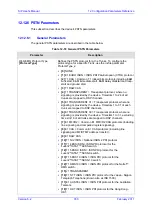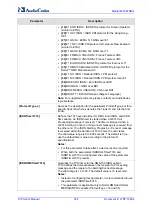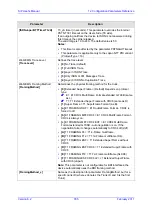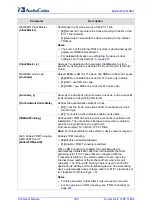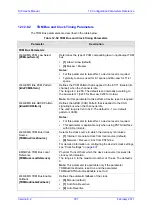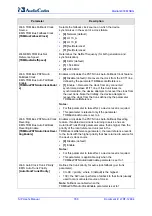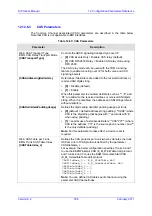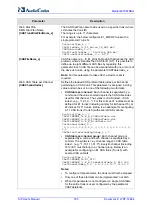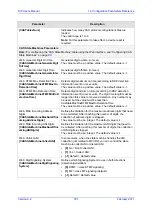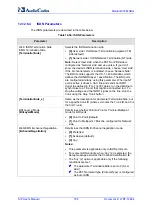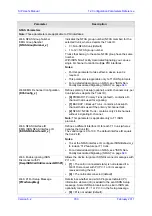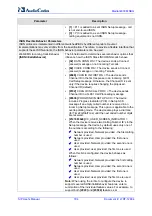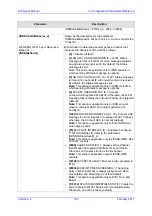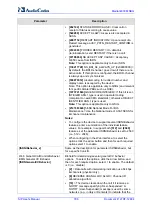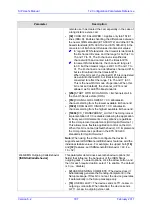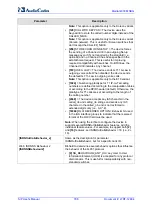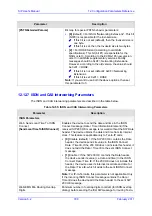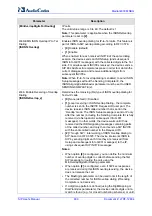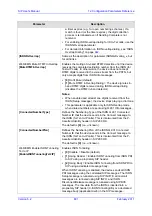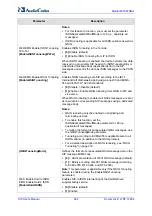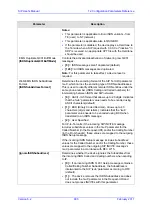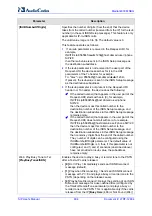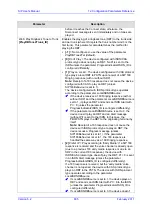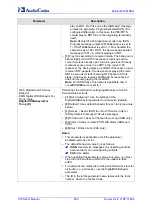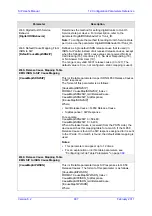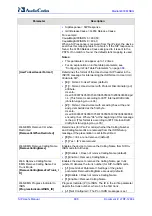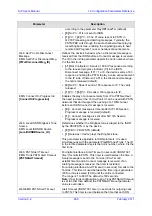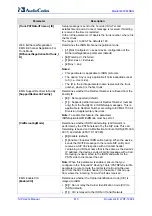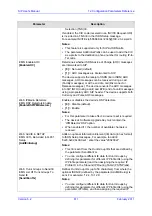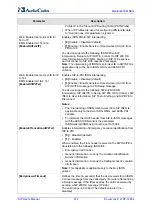
Version 6.2
797
February 2011
SIP User's Manual
12. Configuration Parameters Reference
Parameter
Description
remote user has cleared the call, especially in the case of
a long distance voice call.
[32]
CHAN ID 16 ALLOWED = Applies only to ETSI E1
lines (30B+D). Enables handling the differences between
the newer QSIG standard (ETS 300-172) and other ETSI-
based standards (ETS 300-102 and ETS 300-403) in the
conversion of B-channel ID values into timeslot values:
9
In 'regular ETSI' standards, the timeslot is identical to
the B-channel ID value, and the range for both is 1 to
15 and 17 to 31. The D-channel is identified as
channel-id #16 and carried into the timeslot #16.
9
In newer QSIG standards, the channel-id range is 1
to 30, but the timeslot range is still 1 to 15 and 17 to
31. The D-channel is not identified as channel-id #16,
but is still carried into the timeslot #16.
When this bit is set, the channel ID #16 is considered
as a valid B-channel ID, but timeslot values are
converted to reflect the range 1 to 15 and 17 to 31.
This is the new QSIG mode of operation. When this
bit is not set (default), the channel_id #16 is not
allowed, as for all ETSI-like standards.
[256]
START WITH B CHAN OOS = B-channels start in
the Out-Of-Service state (OOS).
[512]
CHAN ALLOC LOWEST = CC allocates B-
channels starting from the lowest available B-channel id.
[1024]
CHAN ALLOC HIGHEST = CC allocates B-
channels starting from the highest available B-channel id.
[16384]
CC_TRANSPARENT_UUI bit: The UUI-protocol
implementation of CC is disabled allowing the application
to freely send UUI elements in any primitive, regardless
of the UUI-protocol requirements (UUI Implicit Service 1).
This allows more flexible application control on the UUI.
When this bit is not set (default behavior), CC implements
the UUI-protocol as specified in the ETS 300-403
standards for Implicit Service 1.
Note:
When using the
ini
file to configure the device to
support several ISDNGeneralCCBehavior features, add the
individual feature values. For example, to support both
[16]
and
[32]
features, set ISDNGeneralCCBehavior = 48 (i.e.,
16 + 32).
Web/EMS: Outgoing Calls Behavior
[ISDNOutCallsBehavior]
This parameter determines several behaviour options (bit
fields) that influence the behaviour of the ISDN Stack
outgoing calls. To select options, click the arrow button, and
then for each required option, select 1 to enable. The default
is 0 (i.e., disable).
[2]
USER SENDING COMPLETE =The device doesn't
automatically generate the Sending-Complete IE in the
Setup message. If this bit is not set, the device generates
it automatically in the Setup message only.
[16]
USE MU LAW = The device sends G.711-m-Law in
outgoing voice calls. When disabled, the device sends
G.711-A-Law in outgoing voice calls.
Содержание Mediant 800 MSBG
Страница 2: ......
Страница 366: ...SIP User s Manual 366 Document LTRT 12804 Mediant 800 MSBG Reader s Notes ...
Страница 372: ...SIP User s Manual 372 Document LTRT 12804 Mediant 800 MSBG Reader s Notes ...
Страница 390: ...SIP User s Manual 390 Document LTRT 12804 Mediant 800 MSBG Reader s Notes ...
Страница 404: ...SIP User s Manual 404 Document LTRT 12804 Mediant 800 MSBG Reader s Notes ...
Страница 616: ...SIP User s Manual 616 Document LTRT 12804 Mediant 800 MSBG Reader s Notes ...
Страница 636: ...SIP User s Manual 636 Document LTRT 12804 Mediant 800 MSBG Reader s Notes ...
Страница 652: ...SIP User s Manual 652 Document LTRT 12804 Mediant 800 MSBG Reader s Notes ...
Страница 886: ...SIP User s Manual 886 Document LTRT 12804 Mediant 800 MSBG Reader s Notes ...
Страница 890: ...User s Manual Ver 6 2 www audiocodes com ...

